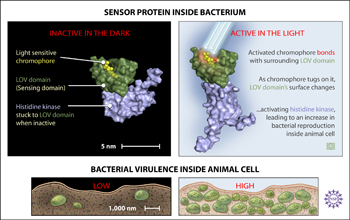All Images
News Release 07-107
Light Brings Out the Worst in Some Disease-Causing Bacteria
Bacteria can sense light, and light exposure increases the virulence of one type of disease-causing bacteria
This material is available primarily for archival purposes. Telephone numbers or other contact information may be out of date; please see current contact information at media contacts.

Researchers have found light-sensitive protein complexes inside certain bacteria. The complex they studied is made up of a sensing domain, abbreviated as "LOV," sitting on top of an enzyme called a "histidine kinase." The light-sensitive component, called the "chromophore," sits inside the LOV domain. When the bacterium is inside its host's cell and light strikes it, the chromophore bonds with the surrounding "cage" of the LOV domain. As the chromophore tugs on it, the LOV domain's surface changes. This possibly brings about a conformation change activating the histidine kinase below. As the histidine kinase activates, bacterial reproduction inside the host's cell increases significantly. It is postulated that the light sensitive complex is a mechanism of survival for the bacterium when besieged by the host's disease-fighting cells.
Credit: Zina Deretsky, National Science Foundation
Download the high-resolution JPG version of the image. (629 KB)
Use your mouse to right-click (Mac users may need to Ctrl-click) the link above and choose the option that will save the file or target to your computer.


